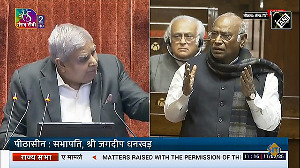With the safeguards agreement with the International Atomic Energy Agency reported to have been concluded at the end of five rounds of formal negotiations, a political showdown seems to be in the offing over the Indo-US nuclear deal.
While all those following the progress of the deal are waiting for the outcome of the safeguards negotiations, it may be appropriate to recapitulate the issues involved for fulfilling oft repeated legitimate aspirations.
While the bilateral agreement with the US will broadly spell out the parameters with in which the deal operates, stipulating the rights and obligations on both sides, the safeguards arrangement with the IAEA will showcase the actual implementation of the agreement.
It is like a passport which all Nuclear Suppliers Group members will also look to for satisfying themselves prior to any waiver in the guidelines for nuclear trade with India. It is through the IAEA safeguards agreement that international inspectors gain access to a majority of our nuclear installations which were hitherto forbidden. Hence India needs to carefully incorporate appropriate firewalls to protect strategic interests.
Model safeguards agreements in vogue in the IAEA at present broadly fall into three categories:
i) Nuclear Weapon States party to the Non-Proliferation Treaty,
ii) Non-NWS party to the NPT,
iii) NNWS not party to the NPT.
As an extension to these there is a fourth category covering states who have signed an Additional Protocol to their safeguards agreements with the IAEA. While there is a Model Additional Protocol (INFCIRC 540) generally applicable to NNWS, each of the five NWS (P5) have adopted Additional Protocols specifically suited to their interests not necessarily complying with the Model AP.
India comes under category (iii) with no Additional Protocol and it is to be seen whether it will be permitted to evolve an India-specific AP somewhat similar to the NWS. This is important as a model AP has provisions for extremely intrusive inspections with no notice or short notice at any time and at locations originally unspecified based on doubts regarding undeclared nuclear activities or unexplained anomalies in nuclear material accounting, physical verification and so on.
India has consistently refused so far to succumb to repeated attempts by the IAEA to sign the AP. The present deal is going to be a different ball game with India agreeing to open up a major portion of our activities to external scrutiny. There is no model available with the IAEA to cover the new category of a NNWS (the tag which India is inevitably accepting) with a nuclear weapons program. This is an issue that should have been have been dealt with during the negotiations and satisfactorily resolved.
Before moving further it is very essential to see how the main concerns are addressed and how they are legally worded. The following are some of the points relevant in this context.
1. The safeguards agreement with the IAEA is triggered basically by the Indo-US bilateral deal which also later becomes also multilateral with the involvement of the NSG. Though it is not clear what will be the status of the interaction with the NSG in case the US bilateral deal runs into problem for any of the reasons, it is important to know what corrective measures India has insisted on and allowed to incorporate in the safeguards agreement in such an eventuality. Is the safeguards commitment in perpetuity tied up with assurances of fuel supply and currency of the bilateral agreement? Also how is the issue of building up strategic reserve of uranium and right of return of nuclear material and equipment dealt with? These are ticklish issues requiring very careful and detailed scrutiny.
2. The final text of the safeguards agreement as and when revealed, will it be a sanitised version or full text? Is the question of Additional Protocol dealt with now or deferred to a later date? Since this is going to be a highly contentious issue it is in our interest to finalise it now along with the main safeguards agreement to avoid roadblocks as we go along. It will be a serious lapse if the discussion on Additional Protocol is deferred possibly due to time constraints.
3. The Separation Plan which was agreed to with lot of fanfare during President George W Bush's visit to India in March 2006 has not found specific mention in the 123 text for some reason. It has statements to the effect that India decides which of the nuclear facilities will be included in the civil list and the sequence. It also spells out exclusions of certain facilities and locations as strategic within the prerogative of India. This should be clearly recognised and incorporated in the safeguards text.
4. The question of safeguards on reprocessing is a complex issue requiring tactful handling since past experience in bilateral with the US on Tarapur was pretty rough. There should not be a repeat of this.
5. Since we have in the 123 text agreed for the implementation of the deal as per national laws without recourse to any international arbitration, we have to be prepared for possible changes in the US laws in future which could have adverse impact on the implementation of the deal itself and the safeguards arrangement. We did face such a situation in Tarapur where a bilateral entered into in 1963 as per the 1954 US Nuclear Act was superceded by the 1778 Nuclear Non Proliferation Act and we were denied supply of fuel agreed to earlier. In the present case, if properly interpreted, as per the 123 agreement not only the Hyde Act but also any amendments or new Acts will be applicable to this deal. This is not wishful thinking but based on actual experience. India has hardly any leverage in forcing any interpretation if it does not match that of the US law.
Though the deal has been discussed in detail at various stages of its progress, before taking a final decision, it is advisable for the law-makers to ponder over various issues of concern dispassionately and seriously once again as the stakes are high involving commitments in perpetuity and once entered into is irreversible.
What is being attempted is creating new history and the outcome should stand the test of time for the long term interests of national security and energy independence. It is dangerous to go with the mindset that our great country cannot survive without this deal! It is an insult to the intellectual strength of our scientists and technologists who have been responsible for making the country proud in this field.
One thing should be borne in mind. If India had not gone ahead with the nuclear tests, US would not be talking to us so seriously and proactively with us about this deal. Let us not underestimate ourselves but act with honor and dignity to play a global role.
A N Prasad is former director of Bhabha Atomic Research Centre and former member, Atomic Energy Commission






 © 2025
© 2025